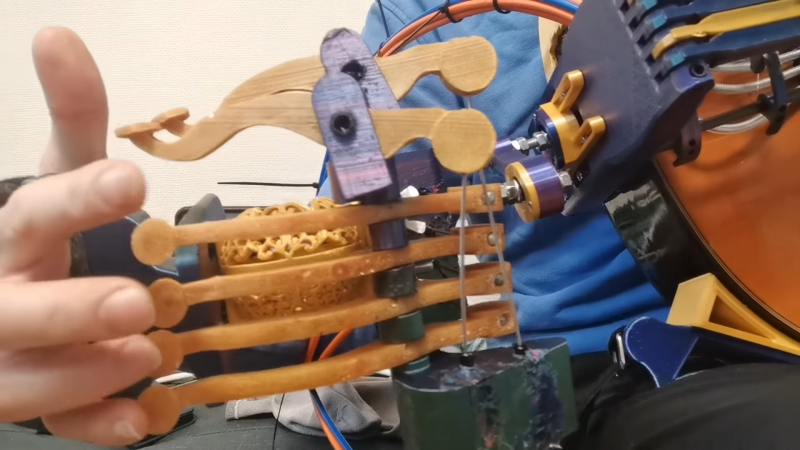If you’re looking for a long journey into the wonderful world of instrument hacking, [Arty Farty Guitars] is six parts into a seven part series on hacking an existing guitar into a guitar-hurdy-gurdy-hybrid, and it is “a trip” as the youths once said. The first video is embedded below.
The Hurdy-Gurdy is a wheeled instrument from medieval europe, which you may have heard of, given the existence of the laser-cut nerdy-gurdy, the electronic midi-gurdy we covered here, and the digi-gurdy which seems to be a hybrid of the two. In case you haven’t seen one before, the general format is for a hurdy-gurdy is this : a wheel rubs against the strings, causing them to vibrate via sliding friction, providing a sound not entirely unlike an upset violin. A keyboard on the neck of the instrument provides both fretting and press the strings onto the wheel to create sound.
[Arty Farty Guitars] is a guitar guy, so he didn’t like the part with about the keyboard. He wanted to have a Hurdy Gurdy with a guitar fretboard. It turns out that that is a lot easier said than done, even when starting with an existing guitar instead of from scratch, and [Arty Farty Guitar] takes us through all of the challenges, failures and injuries incurred along the way.
Probably the most interesting piece of the puzzle is the the cranking/keying assembly that allows one hand to control cranking the wheel AND act as keyboard for pressing strings into the wheel. It’s key to the whole build, as combining those functions on the lower hand leaves the other hand free to use the guitar fretboard half of the instrument. That controller gets its day in video five of the series. It might inspire some to start thinking about chorded computer inputs– scrolling and typing?
If you watch up to the sixth video, you learn that that the guitar’s fretting action is ultimately incompatible with pressing strings against the wheel at the precise, constant tension needed for good sound. To salvage the project he had to switch from a bowing action with a TPU-surfaced wheel to a sort of plectrum wheel, creating an instrument similar to the thousand-pick guitar we saw last year.
Even though [Arty Farty Guitars] isn’t sure this hybrid instrument can really be called a Hurdy Gurdy anymore, now that it isn’t using a bowing action, we can’t help but admire the hacking spirit that set him on this journey. We look forward to the promised concert in the upcoming 7th video, once he figures out how to play this thing nicely.
Know of any other hacked-together instruments that possibly should not exist? We’re always listening for tips.
















Yeah, string to wheel alignment is pretty much the determining factor in how a hurdygurdy sounds. A fretboard that has frets that pop out to touch the string might work, but then really you’re back into making a full hg with keyboard.
Interesting that TPU worked at all. Mine have extremely smooth, hard wooden wheels, and I apply rosin to get the string vibrating, like a violin bow. I would have thought TPU to be way too sticky because of its depth, for lack of a better term: the string could sink into it. But I guess if it’s just skimming the surface?
There’s a guy who’s trying to productise his project of making small hurdy gurdys with mass market ukulele bodies. It’s been a while since I checked on his progress, and he’s had a bit of a problem with lashing out at negative reviews of his progress. I’d definitely get one if he’s every successful.
I wonder if [Arty Farty] is biting off a few too many projects at at time with this one; his string controller crank handle looks massively clumsy, I can’t imagine how you’d get a good trompette pattern going with that; and having to adjust the whole fretboard into a fretted cello fingerboard seems like bit of a waste. I reckon he should have had a go at making a more standard hurdy gurdy from a guitar body first.
I certainly wouldn’t be coordinated enough for that claw-clank-contraption, but that’s part of what made me think it was impressive!
This guy has a hurdy gurdy style guitar mod that is intriguing. https://youtu.be/1fVSCuUCHtA
That one sounds heavenly, doesn’t it?
The algorithm tossed me that video too. In fact, I was just writing an article about the Cantareel, but I’m going to credit you for the tipoff anyway.
Thanks!
Well, as a musician and engineer I would say, just because you can, should you? I mean I like the effort and creating something new is always exciting, but the hurdy-gurdy already exists and this sounds nothing like it. So, +1 for the effort, -1 for the usefulness. Next, make a flute sounds like a saxophone!
I would have appreciated more an attempt do build a new instrument from scratch. But fun is fun! Good job
Why shouldn’t you?
Why would anyone use a raspberry pi to make a cyberdeck when you can just buy a laptop.
Why would anyone automate a fume hood as you can just turn it on yourself?
Why would anyone try to make the fastest beanie there is when you can buy one for a few euro’s in the store?
This is hackaday. The entire point is to reengineer something for the fun of it.
If someone can make a flute sound like a saxophone, I’m more than interested without being able to play either instrument.
A French “roller” at the tone mouth may do that. Actually the effect makes a string tone, invented a century or two ago for different pipe organ voices. I’ve often wondered about this, putting fingerholes on a salicional pipe. No joke! There is also the buzzy kazoo membrane used on a type of Chinese flute.
If you find yourself in a pickle, just think, “what would Rube Goldberg do”.